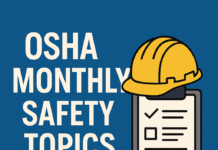
OSHA Violations of 2023
In the ever-evolving landscape of workplace safety, OSHA (Occupational Safety and Health Administration) plays a pivotal role in ensuring the well-being of employees. As we delve into 2023, it’s crucial to shed light on the top OSHA 10 violations that have garnered attention. Understanding these violations not only keeps businesses informed but also contributes to creating safer work environments.
Introduction
Brief Overview of OSHA
OSHA, established to enforce standards that ensure the health and safety of workers, plays a crucial role in mitigating workplace hazards. Compliance with OSHA regulations is not just a legal obligation but a moral responsibility for employers.
Importance of OSHA Compliance
Compliance with OSHA guidelines not only safeguards employees but also protects businesses from potential legal repercussions. Prioritizing safety contributes to a positive workplace culture and enhances overall productivity.
Introduction to OSHA Violations
OSHA violations occur when businesses fail to adhere to the established safety standards. These violations are categorized based on their severity and can result in fines, penalties, and, in extreme cases, business closures.
Understanding OSHA 10
Explanation of OSHA 10 Certification
OSHA 10 certification is a comprehensive training program designed to educate workers on recognizing and preventing workplace hazards. It serves as a fundamental step towards creating a safer working environment.
Significance for Workers and Employers
For workers, OSHA 10 certification signifies a commitment to safety, while employers benefit from reduced accidents, lower insurance costs, and improved compliance with regulations.
Overview of OSHA Violations in 2023
Importance of Staying Informed
Staying informed about the latest OSHA violations is crucial for businesses to address potential risks proactively. This knowledge empowers employers to take preventive measures and prioritize employee safety.
Overview of the Top OSHA 10 Violations in 2023
Before diving into the specifics, let’s take a look at the overarching categories of OSHA 10 violations that have been prevalent in 2023.
Most Common Violations
Violation 1: Lack of Fall Protection
One of the leading causes of workplace injuries, the absence of adequate fall protection measures poses a significant risk to workers. Employers must prioritize the implementation of safety measures such as guardrails and personal fall arrest systems.
Violation 2: Inadequate Hazard Communication
Proper communication of workplace hazards is a cornerstone of safety. Failure to effectively communicate potential risks through labels, signs, and training materials can lead to accidents and OSHA violations.
Violation 3: Unsafe Scaffolding Practices
Improper use of scaffolding is a prevalent hazard in construction and related industries. Adhering to OSHA standards regarding scaffolding is crucial to prevent accidents and ensure the well-being of workers.
Violation 4: Lack of Respiratory Protection
In environments where respiratory hazards are present, the absence of adequate respiratory protection measures can lead to severe health consequences. Employers must provide proper equipment and training to mitigate these risks.
Impact on Workplace Safety
Consequences of OSHA Violations
OSHA violations have far-reaching consequences, including fines, legal actions, and damage to a company’s reputation. More importantly, these violations jeopardize the safety and well-being of employees.
Importance of Creating a Safe Working Environment
Prioritizing workplace safety goes beyond mere compliance. It fosters a culture of responsibility, boosts employee morale, and contributes to long-term success.
Steps to Ensure OSHA Compliance
Employee Training Programs
Investing in comprehensive training programs ensures that employees are equipped with the knowledge and skills needed to identify and mitigate workplace hazards.
Regular Safety Inspections
Frequent safety inspections help identify potential issues before they escalate. Employers should conduct regular inspections, address any concerns promptly, and document the findings.
Creating a Culture of Safety
Building a culture where safety is ingrained in the company’s values encourages employees to actively participate in maintaining a secure work environment.
Addressing OSHA Violations
Corrective Actions for Common Violations
In the event of an OSHA violation, swift and effective corrective actions are essential. This not only rectifies the immediate issue but also demonstrates a commitment to ongoing safety.
Importance of Swift Corrective Measures
Delaying corrective measures can exacerbate the consequences of violations. Taking prompt action showcases a proactive approach to employee safety and regulatory compliance.
Staying Updated on OSHA Regulations
Importance of Keeping Abreast of Changes
OSHA regulations may evolve over time. Employers must stay informed about any updates or changes to ensure continued compliance and the highest standards of safety.
Resources for Staying Informed
Utilizing OSHA’s resources, including publications, training materials, and online platforms, helps businesses stay abreast of the latest regulations and best practices.
OSHA Compliance Benefits
Improved Workplace Safety
Prioritizing OSHA compliance results in a safer workplace, reducing the risk of accidents and injuries. This, in turn, enhances employee well-being and overall productivity.
Avoidance of Penalties and Fines
Compliance not only prevents accidents but also shields businesses from costly penalties and fines associated with OSHA violations.
Real-life Consequences
Case Studies of Companies Facing OSHA Violations
Examining real-life scenarios where companies faced OSHA violations provides valuable insights into the consequences of non-compliance and the importance of preventive measures.
Lessons Learned from Real-life Incidents
Learning from the mistakes of others reinforces the significance of adhering to OSHA guidelines and underscores the importance of a proactive safety approach.
OSHA Best Practices
Implementing OSHA Guidelines Effectively
Adopting OSHA guidelines in a practical and effective manner involves understanding the unique needs of a workplace and tailoring safety measures accordingly.
Encouraging Employee Participation
Fostering a sense of responsibility among employees for their own safety and the safety of their colleagues is paramount. Employee engagement is a key factor in maintaining a safe working environment.
Importance of Continuous Training
Ongoing Education for Employees
Continuous training ensures that employees are updated on the latest safety protocols and are equipped to handle evolving workplace hazards.
Benefits of Continuous Learning in Safety
A commitment to ongoing education not only ensures compliance but also cultivates a culture of continuous improvement and innovation in workplace safety.
Conclusion
In conclusion, understanding and addressing the top OSHA 10 violations of 2023 is essential for fostering a safe and productive work environment. Prioritizing compliance, implementing corrective measures, and learning from real-life incidents are crucial steps towards creating a workplace where safety is paramount.
OSHA Safety Officer Certification
OSHA Safety Manager Requirements
OSHA Safety Engineer Requirements
OSHA Safety Officer Requirements
How To Become OSHA Safety Manager 2024
FAQs
How often should safety training be conducted?
Regular safety training should be conducted at least annually, with additional sessions as needed based on changes in the workplace or new safety hazards.
What are the penalties for OSHA violations?
Penalties for OSHA violations vary based on the severity of the violation, ranging from fines to potential business closures. It is essential to address violations promptly to avoid legal repercussions.
Can small businesses afford OSHA compliance?
Yes, OSHA provides resources and guidelines that cater to businesses of all sizes. Investing in safety measures ultimately outweighs the potential costs of non-compliance.
How can employees contribute to a safer workplace?
Employees play a vital role in safety by adhering to guidelines, reporting hazards, and actively participating in safety programs. Their vigilance contributes to a collectively safer workplace.
Are there specific industries more prone to OSHA violations?
Certain industries, such as construction and manufacturing, may have higher risks, but violations can occur in any sector. Understanding industry-specific hazards is key to preventing violations.

























I have learnt something different concerning about our environment to make zero harm accidents and in order de safety of employer and workers
OSHA is like worker compensation they only car about employeerrrrrs